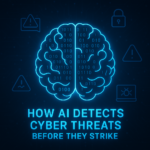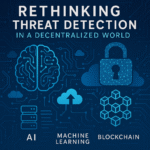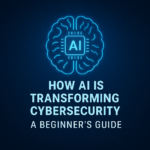Introduction to AI in Cybersecurity
In an era where cyber threats are rapidly evolving, traditional security systems are no longer sufficient to protect sensitive data. Businesses and organizations across the globe are turning to AI-driven threat detection is transforming cybersecurity by enabling organizations to detect and stop threats in real time. As cyberattacks grow more sophisticated, traditional tools often fall short, making AI essential for proactive defense.
What is AI-Driven Threat Detection?
AI-driven threat detection refers to the use of artificial intelligence algorithms to monitor, detect, and respond to security threats across digital environments. Unlike rule-based systems, AI systems learn from vast amounts of data, adapt to new threat patterns, and make decisions without human intervention.
Key Technologies Behind AI Threat Detection
- Machine Learning (ML): Enables systems to learn from historical threat data and identify patterns.
- Natural Language Processing (NLP): Analyzes textual data such as phishing emails or malware code descriptions.
- Anomaly Detection: Identifies deviations from normal behavior that may indicate a breach.
- Behavioral Analytics: Tracks user behavior and flags suspicious activity in real time.
According to IBM’s research on AI in cybersecurity, artificial intelligence enhances threat detection by reducing detection time and increasing accuracy through behavioral analytics and machine learning.
Why AI-Driven Detection is Critical Today
Cyberattacks are more sophisticated and frequent than ever before. Ransomware, phishing, insider threats, and advanced persistent threats (APTs) can bypass traditional defenses. Here’s why AI is essential:
- Real-Time Monitoring: AI continuously monitors systems 24/7, offering real-time protection.
- Faster Response Times: Reduces the time it takes to detect and contain breaches.
- Scalability: AI can analyze massive volumes of data without performance issues.
- Reduced False Positives: Machine learning models become more accurate over time.
Real-World Use Cases of AI in Threat Detection
1. Email Security
AI helps detect phishing attempts by analyzing the content, sender behavior, and URL patterns in emails.
2. Endpoint Protection
AI-enabled antivirus solutions identify and isolate malicious behavior on user devices before damage is done.
3. Network Intrusion Detection
By continuously learning normal network behavior, AI can quickly flag unusual activities and potential intrusions.
4. Insider Threats
AI can detect employees who deviate from usual access patterns, potentially stopping data breaches from within.
5. Cloud Security
In cloud environments, AI monitors user access, API calls, and configuration changes for malicious intent.
Benefits of AI-Driven Threat Detection
BenefitImpact
Speed Detects threats in milliseconds
Accuracy Reduces false alarms through continuous learning
Automation Automates repetitive threat hunting tasks
Cost Efficiency Minimizes the need for large cybersecurity teams
Proactive Defense Predicts threats before they happen
Challenges and Limitations
While AI offers significant benefits, it is not without challenges:
- Data Quality: Poor data can lead to inaccurate detection.
- Adversarial AI: Hackers can use AI to bypass AI-based defenses.
- Cost of Implementation: High initial costs for AI adoption.
- Skill Gaps: Requires skilled professionals to manage and fine-tune models.
Best Practices for Implementing AI in Threat Detection
- Start with Clear Goals: Define what threats you’re trying to detect (malware, DDoS, phishing, etc.).
- Use High-Quality Data: Ensure training data is relevant and up-to-date.
- Integrate with SIEM Tools: Connect AI detection systems with security information and event management (SIEM) tools for streamlined operations.
- Regularly Update Models: Keep AI models trained on the latest threat intelligence.
- Maintain Human Oversight: Combine AI with human expertise for decision validation.
Future Trends in AI-Driven Cybersecurity
- Explainable AI (XAI): Making AI decision-making transparent and understandable.
- Autonomous Security Operations: Fully automated threat response and mitigation.
- Federated Learning: Secure AI training across decentralized data sources.
- AI-Powered Threat Intelligence Sharing: Collaborative AI ecosystems to fight global cyber threats.
Conclusion
AI-driven threat detection is transforming how we approach cybersecurity. As cyber threats become more complex, the need for intelligent, adaptive, and automated defense systems grows stronger. By integrating AI into cybersecurity strategies, organizations can achieve faster threat detection, more accurate risk assessments, and enhanced protection against both known and unknown threats.
Learn more about How AI is Transforming Cybersecurity: A Beginner’s Guide, including risk scoring, automation, and predictive analytics.





Leave a Reply